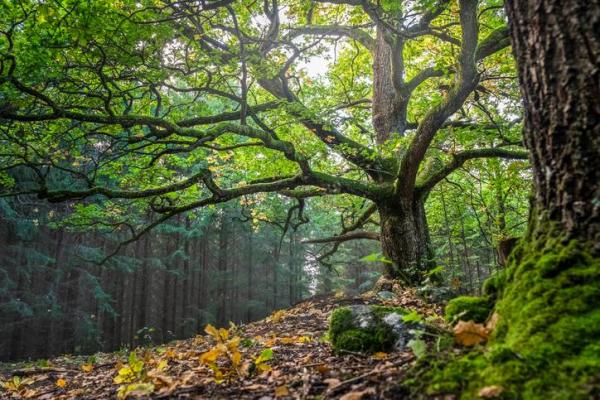Which Plants and Animals Live in the Temperate Forest?


Temperate forest biomes are very diverse, as we can distinguish between different types, such as temperate deciduous forests, temperate rainforests, temperate coniferous forests, temperate deciduous forests, or mixed temperate forests, to name a few. These forests, as their name implies, are located in the temperate zones of the earth. They are home to numerous species of plants, animals, fungi, and microorganisms.
The following thedailyECO article explains which plants and animals live in temperate forests, as well as some of the most important features of these forests.
What is a temperate forest and its characteristics
The temperate forest extends across the Northern Hemisphere in central and Western Europe, north of the United States and Canada, east of Russia, north of Scandinavia and Russia, and in parts of Japan and China. In contrast, if we look at the distribution of temperate forests in the Southern Hemisphere, we find that they are found in New Zealand and the southern edge of South America. Below, we will explain in more detail the particular characteristics of this type of forest:
- Temperatures are usually moderate, with a marked seasonal pattern. The average temperatures are between 5 and 23 °C, although in winter the temperature can reach below zero degrees Celsius.
- Temperate forests are located in areas with abundant and evenly distributed precipitation. The average annual precipitation is between 500 mm – 2000 mm.
- The flora and fauna of temperate forests are very diverse, although many animals migrate or hibernate.
- The dense vegetation cover and warm, humid summers allow maximum development of organic matter that forms a well-developed humus layer, generally in clayey soils.
- The soil is rich and fertile. The surface is dark brown and slightly acidic. Underneath there are redder layers formed by the accumulation of iron oxides.
- These forests are structurally complex. Some of them host a wide variety of plant species, which in turn provide both food resources and space for a wide variety of animals.
- The terrain of these forests is very diverse. Depending on the geographical region, they can occur in plains, valleys, or mountains.
- Temperate forest covers 25% of the planet's forest area, second only to the boreal forest, which covers about 33%.
- They differ from other, more lush forests in that they have a much less dense canopy, so you can see the sky through the undergrowth.
- Temperate forests have been particularly affected by human activity because they are located in the mid-latitudes, where much of the world's population lives. Most of these forests have been cut down to build cities and make room for cultivation. They have also been subject to mining, logging, hunting, pollution, deforestation, and habitat loss for centuries.
Plants of the temperate forest
When we talk about the flora of temperate forests, it is important to mention that seasonal changes play a key role. These forests consist mainly of deciduous trees, whose foliage differs greatly from that of evergreen trees. Deciduous trees shed their leaves in the fall and produce new leaves in the spring. In fact, in the spring, there is an explosion of growth and flowering of herbaceous species.
During spring growth, when the foliage of the trees has not yet fully formed, a lot of light reaches the ground and makes the plants grow on the ground. For this reason, many of the ground-dwelling species grow, flower, and bear fruit before late summer. Later, sciophilous plants, plants that like shade, begin to grow. Because of their highly efficient mechanisms for capturing and exploiting low-intensity light, these plants are able to survive even when foliage completely covers the ground.
Temperate forest consist of several layers, with 1 or 2 layers of trees, a shrub layer, and a herb layer. Lianas are also more widespread than in other temperate forests, perhaps because they can compete for light when trees have lost their leaves.
In some forests deciduous species predominate, adapted to the arrival of cold weather with possible frosts and snowfalls, while in other forests conifers species predominate, resulting in temperate deciduous forests or temperate coniferous forests.
As we can see, the vegetation of this type of forest is very diverse, but in general we can highlight the following species.
The main trees in this biome are:
- Beech (Fagus selvatica)
- Sycamore (Acer pseudoplatanus)
- Oak (Quercus spp.)
- Aspen (Populus tremula)
- Walnut (Juglas regia)
- Linden (Tilia cordata)
- Chestnut (Castanea sativa)
- Birch (Betula pendula)
- Elm (Ulmus carpinifolia)
- Tulip trees (Liriodendron tulipifera)
The main shrubs in this biome are the Ericaceae and Rosaceae families:
- Enkianthus
- Arbutoideae
- Pyroloideae
- Epacridoideae
- Amygdaloideae
- Dryadoideae
The main herb families include:
- Caryphyllaceae
- Compositae
- Cruciferae
- Labiatae
- Ranunculaceae
- Umbelliferae
There are also grasses and sedges that can grow in the open gaps of the forest. These plants provide food for deer and insects.

Animals of the temperate forest
The seasons also play a major role for the animals that live in these forests. Due to seasonality and the lack of complex stratification, there are fewer mammals in this biome than in tropical forests. The animals of this biome eat and store food in the fall. They especially like walnuts and winged seeds, which keep for a long time.
Many mammals and birds have developed a number of strategies to survive the rigors of winter. Many species sleep through the winter, well protected in their burrows, and some animals even hibernate properly. This makes them low-visibility animals, some of them nocturnal, others hiding in the grass.
Now let us take a closer look at some of the most common species that live in these forests:
- Large herbivores: elk (Cervus canadensis), wild boar (Sus scrofa), reindeer (Rangifer tarandus), white-tailed deer (Odocoileus virginianus), deer (Cervus elaphus).
- Wild hunters and omnivores: brown bear (Ursus arctos), wolf (Canis lupus), fox (family Canidae), Asian golden cat (Catopuma temminckii), European badger (Meles meles).
- Birds: among the many birds that live in these forests are the passerine birds (Passeriformes), which make up more than half of all known birds. This group includes birds that feed on fruits, i.e., frugivorous, or insects, also called insectivorous.Some birds, including songbirds, migrate south after storing enough fat.
There are also numerous insects, rodents, and squirrels that are usually found on the ground, in the grass, and in leaf litter.

If you want to read similar articles to Which Plants and Animals Live in the Temperate Forest?, we recommend you visit our Ecosystems category.







